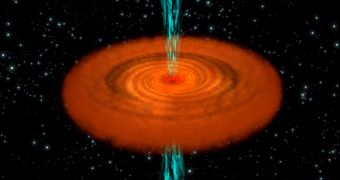Quasars are basically black holes surrounded by large accretion disks of matter spinning around them. As matter is being drawn to the central black hole, it heats up and starts emitting high amounts of radiation, while powerful magnetic fields eject part of the material back into the surrounding space before crossing the event horizon.
Eventually, this material will flow into interstellar space, where it creates disturbances so powerful in the gas inside the galaxy that it is even able to stop star formation processes. Because of this, quasi-stellar objects present valuable information to astronomers studying galaxy formation and evolution.
Researchers from the Center for Astrophysics at the University of Science and Technology in China, using the XMM-Newton telescope in their study, have revealed that NASA's X-ray Space Telescope detected a new type of galaxy which appears to contain high numbers of X-ray sources, most likely quasars. Quasars are quite common in the universe, since they are powered by black holes; however, the newly discovered quasar is part of a class called 'broad absorption line,' or BAL, quasars which are responsible for only 10 to 20 percent of the whole quasar population.
BAL quasars eject matter through their equatorial regions, in the direction of the accretion disk, but emit extremely low X-ray radiation, which must mean that the accretion disk is so large that any emitted X-ray light is immediately re-absorbed into the gas disk. Other types of BAL quasars eject matter through the polar region, perpendicular to the accretion disk plane.
Jun Xian Wang and his colleagues used the data provided by XMM-Newton mostly to study BAL quasars ejecting matter through their polar regions, in order to determine whether the X-rays were absorbed strongly in the accretion disk. Between 2006 and 2007, they observed that two of the studied objects suddenly started to emit much higher X-ray light than expected, like the large part of the accretion disk disappeared without notice.
"Our results can help refine the computer simulations of how these quasars work," says Wang. "Perhaps there can be both equatorial outflows and polar outflows simultaneously from these objects. Maybe, the outflows are even produced by similar means."
According to their computer simulations, the material ejected both through the polar regions and through the equatorial is falling towards the black hole under the powerful gravitational pull; however it never reaches the event horizon and is ejected back into space by radiation pressure. Wang believes that further observations need to be made before concluding their work. "We need more data so that we can look into the details of the X-ray emission," says Wang.

 14 DAY TRIAL //
14 DAY TRIAL //